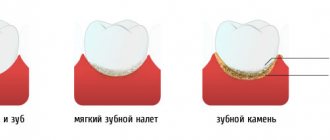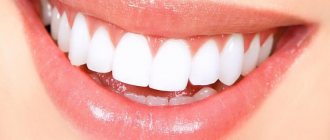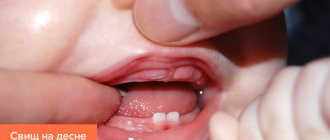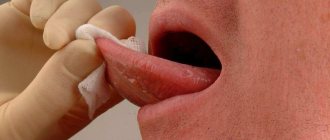Anyone can chip off a piece of their tooth, regardless of whether you take care of your teeth or not. Most often, this is preceded by a mechanical impact on the tooth, less often - gradual destruction of the integrity of the tooth, cracks in the enamel or the development of caries. The most common case is a blow, fall or other injury. Sometimes a tooth can chip when chewing, both in the front and back teeth. Moreover, you don’t have to chew nuts. Quite often, a tooth can break off when trying to bite off a piece of dry salted fish or meat.
It's clear. The way to avoid such a case is to be careful! In the article we will consider points that can increase the likelihood of an unpleasant incident.
Differences between a chipped tooth and other types of damage
In dentistry, a chipped tooth is any type of mechanical damage leading to disruption of the anatomy and structure of tissues. Experts have different interpretations of this concept. For example, you can find diagnoses such as “chipped the tooth wall below the gum level” or “chipped the tooth wall under the gum.” However, in the classical sense, this is damage to the coronal part (in other words, a chipped tooth crown). Trauma does not imply its loss or change in position relative to the jaw and damage to the ligamentous apparatus. You should also distinguish between chips and root fractures, since in the second case the damage affects the root part. In this case, combined injuries also occur, when, for example, a chip of the crown part and tooth dislocation are diagnosed at the same time.
Free consultation
Our specialists will conduct a free consultation and select the best treatment option for you.
Sign up now! Online registration
+7 (495) 649-41-19
Content
1 What methods of dental restoration exist?
2 Stages of dental restoration
3 Dental restoration before and after photos
4 What influences the price of tooth restoration? 4.1 Complete crown correction
4.2 If half a tooth needs to be restored
4.3 Restoration of a chipped cutting edge of a front tooth
5 What are the disadvantages of artistic dental restoration?
6 Alternative to composite restoration
7 Prices for dental restoration
Causes
- Dental trauma. Falls and impacts are the main reason why chips and cracks occur in perfectly healthy teeth;
- Negligence towards one’s health and bad habits (opening beer bottles with teeth, cracking hard nuts with them, gnawing hard objects, etc.);
- Demineralization of tooth enamel. A process that leads to weakening of enamel and increased risk of injury;
- Carious lesions. They damage the structure of enamel and dentin and thereby make the tooth more vulnerable to mechanical stress. Depulpation completely “kills” the tooth: the tissues, not receiving nutrition from the pulp, become very fragile;
- Bite abnormalities. Cause improper load distribution, which increases pressure on individual teeth or areas of the dentition;
- Incorrect filling. Due to an incorrectly installed filling, the chewing tooth often chips;
- Poor nutrition and poor hygiene. An indirect cause that affects dental health in general;
- Weakened immunity, bad genetics.
What can cause damage to enamel
As mentioned above, the most common cause of chipping is mechanical factors. Among them, dental experts identify the following common prerequisites:
- careless chewing of hard foods, attempts to crack nut shells with teeth or chew hard crackers,
- getting small hard objects into the oral cavity, for example, fragments of fish bones or fine sand,
- the habit of chewing the tip of a pencil or biting off thread with your teeth,
- bruxism or involuntary grinding of teeth during sleep,
- blows, bruises and injuries.
The habit of chewing on a pen can provoke a chipped tooth.
Moreover, if demineralization of the enamel occurs due to the development of carious processes, hormonal disorders, chronic diseases or acute deficiency of vitamins and minerals in the body, the teeth will be more susceptible to traumatic factors. In this case, defects may result from contact of the enamel with food and drinks that are too hot or cold.
It should also be noted that smoking and alcohol abuse lead to the weakening of the top layer covering the crowns. The enamel becomes thinner, becomes sensitive, and hyperesthesia develops. In such a situation, almost any sudden mechanical or temperature impact can lead to the formation of microcracks and chips.
Classification of chips
| Types of chips | Description |
| Chip of tooth enamel | The easiest type of chipping, in which only the enamel structure is damaged. These could be cracks or a small chip in the tooth. There is no pain, but lack of treatment can worsen the situation. In addition, even a small chip on a tooth has a negative impact on aesthetics. |
| Dentin chip | As a result of mechanical stress, the dentin layer is damaged. The most common types of such injuries are chipped tooth walls on molars and chipped front teeth. In addition, untreated chips and cracks in the enamel can subsequently worsen and reach the pulp. |
| Severe chipped tooth | These are serious cracks and fractures that significantly damage the crown part of the tooth. Sometimes a tooth splits, when it seems to split into two parts, which severely injures the pulp and dentin. Such chips require long and complex treatment. |
Precautionary measures
Tips for avoiding chipped teeth follow general oral health tips:
- Visit your dentist regularly for dental examinations and professional teeth cleanings;
- taking vitamin and mineral complexes;
- brush your teeth morning and evening;
- limit the consumption of sweets, carbonated water, juices;
- do not smoke and limit alcohol consumption;
- treat teeth in the early stages of disease development;
- Treat diseases of organs and systems in a timely manner.
It is important to understand that an untreated tooth can lead to complications - from simple to very serious. Most often we are talking about caries, pulpitis, periodontitis. Doctors will confirm to you that a chipped tooth and infection can cause the development of chronic diseases of the heart, kidneys, stomach, liver, and nervous system.
INNOVASTOM offers an integrated approach to the treatment and prevention of dental and gum diseases in Smolensk. We are confident that we will help you maintain the health of your teeth!
Restoring a chipped tooth
Most patients after mechanical damage have a logical question: how to fix a chipped tooth? The treatment method for chipped teeth depends entirely on the type and degree of damage. Today, technology makes it possible to restore a chipped tooth of almost any severity, but this requires resorting to complex and expensive therapeutic and orthopedic procedures.
| Problem | Description of methods |
| Light chips and cracks (treatment of chipped tooth enamel) | For minor enamel cracks, mineralization and fluoridation are used to restore its protective functions and prevent the cracks from deepening. For minor damage, filling is usually not required. If there is no risk to functionality and aesthetics, then the doctor suggests grinding down the chipped tooth. |
| Moderate chips | If the damage has affected the dentin, then filling is no longer possible. The same can be said about severe chips and cracks in the enamel. Often, chipped teeth are built up with composite materials and restored with inlays. |
| Heavy enamel chips. | If the pulp has been affected, then before starting to restore the chipped tooth, it is necessary to carry out endodontic treatment with removal of the pulp and filling of the canals. In case of chips under the gum and deep clefts of the tooth, its complete or partial removal with subsequent installation of a crown or implant may be indicated. In situations where a large part of the tooth is missing, installing veneers and inlays is almost impossible. |
Possible consequences
Below, you can familiarize yourself with the most common consequences of not visiting a dentist in a timely manner:
- Pulpitis. If the enamel is damaged, the risk of harmful microorganisms entering the soft pulp tissue is extremely high;
- Significant discomfort while eating due to increased sensitivity. This is felt especially strongly when eating cold, hot or sour foods;
- Inflammation of the gums and tooth roots;
- If the enamel is severely damaged, there is an increased risk of it falling out due to increased mobility;
- Formation of cysts, granulomas as a result of the inflammatory process.
In order to eliminate dangerous consequences, it is important to take an x-ray. If serious violations are detected, the doctor will prescribe treatment and take measures to prevent consequences.
Chipped front tooth
The chips on the front ones need to be mentioned separately, since the treatment here is aimed at restoring aesthetics. A small chip on a front tooth can be corrected with grinding. In case of noticeable chips of enamel and dentin, the chipped front tooth is built up using filling materials or veneers are installed. For more severe damage, crowns are installed. Usually these are products made of ceramics or zirconium, since metal ceramics are less aesthetically pleasing and can oxidize. If a tooth has chipped under the gum or has split into two halves, most often the patient is offered removal and installation of an implant. Restoration requires the use of a certain type of filling that meets high aesthetic requirements. Most often, photopolymer or compomer fillings are used to treat a chipped front tooth.
Three stages of diagnosis
Diagnosis is carried out during a dental examination:
- The location of the erosive defect is identified by drying the tooth surface with an air jet and applying iodine.
- The process of differentiating erosion from a wedge-shaped defect and primary stage caries. Erosion from caries will be distinguished by the location and shape of the lesion, as well as a smooth surface; with caries, the surface becomes rough. The wedge-shaped defect will also differ in shape and location. It is found in the area of the tooth root.
- In order to identify concomitant pathologies of the endocrine system, an examination is carried out by an endocrinologist and gastroenterologist, an ultrasound of the thyroid gland is prescribed, and a hormonal analysis of the thyroid gland is performed.
Prevention of chips of enamel and tooth wall
Dental injuries are usually sudden, so it is quite difficult to insure against them. However, preventing chips does not consist only of wearing protective mouthguards. It has already been said that dental health is influenced by many factors, including hygiene and proper nutrition. This is where you should start if you want to keep your teeth strong and healthy. Indirect causes should also be addressed. If you have an overbite or bruxism, start receiving appropriate treatment as soon as possible. Get rid of the bad habit of gnawing on foreign objects, be careful with solid foods, especially seeds and nuts. If you have naturally weak enamel, use products to strengthen it. Remember that you are given one permanent set of teeth for life, so taking care of its preservation is our direct responsibility
Publisher: Expert magazine about dentistry Startsmile.ru
Author of the material: Yaroslav Ikonnikov
Means for strengthening enamel at home
You can strengthen the enamel layer at home using products that contain fluoride. These can be either regular strengthening toothpastes or special products, for example, fluoride-containing enamel varnishes. The frequency and characteristics of the use of certain drugs depend on their composition and properties.
Important! It must be remembered that fluoride in large quantities can have a negative effect on the body. Therefore, you should use products containing this substance only in accordance with your doctor’s recommendations.
Alternative to composite restoration
- Veneers. When dental restoration with photopolymers takes place, the price is not in doubt among patients and they immediately agree to the procedure. However, there are cases when a more preferable option for restoring teeth is installing veneers. The need to apply such reinforcing plates arises if tooth decay occurs only in the anterior part, and on the lingual side the tooth is only slightly damaged.
Moreover, it is better to install ceramic veneers, which do not lose their shine over time and do not fade. Despite all the advantages that such alternative dental restoration has, its price in Moscow remains high.
Even in budget dental clinics, installing veneers will cost you no less than 15,000 rubles. In high-level metropolitan dentistry, prices for veneers made of zirconium can reach 30-40 thousand rubles. However, this price includes all additional costs associated with anesthesia, x-rays, impressions and even a temporary plastic crown.
In our clinic, a ceramic veneer costs 25 thousand rubles, and the price of a zirconium veneer is 15 thousand rubles.
- Artificial crowns . Also, if there is significant destruction of the dental unit (more than 50%), the priority option is to install an artificial prosthesis. This is due to the fact that complete tooth restoration (from the root) has a cost similar to a metal-ceramic crown. However, in terms of strength and aesthetic parameters, the latter is considered a more preferable choice.
- Inlays . If necessary, a special restorative inlay can be used to restore chewing teeth. If such an inlay is made of ceramic material, it is more durable, stronger and more aesthetically pleasing than composite fillings.










